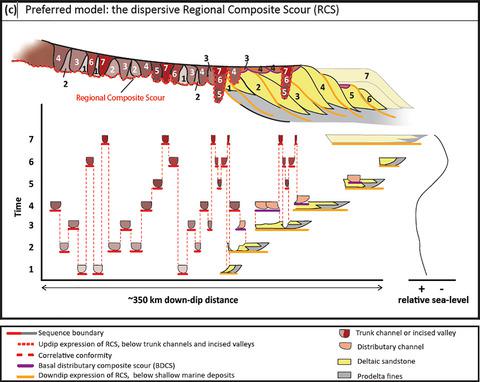当前位置:
X-MOL 学术
›
Basin Res.
›
论文详情
Our official English website, www.x-mol.net, welcomes your
feedback! (Note: you will need to create a separate account there.)
Low‐accommodation and backwater effects on sequence stratigraphic surfaces and depositional architecture of fluvio‐deltaic settings (Cretaceous Mesa Rica Sandstone, Dakota Group, USA)
Basin Research ( IF 2.8 ) Pub Date : 2020-06-12 , DOI: 10.1111/bre.12483 Anna E. van Yperen 1 , John M. Holbrook 2 , Miquel Poyatos‐Moré 1 , Cody Myers 2, 3 , Ivar Midtkandal 1
Basin Research ( IF 2.8 ) Pub Date : 2020-06-12 , DOI: 10.1111/bre.12483 Anna E. van Yperen 1 , John M. Holbrook 2 , Miquel Poyatos‐Moré 1 , Cody Myers 2, 3 , Ivar Midtkandal 1
Affiliation

|
The adequate documentation and interpretation of regional‐scale stratigraphic surfaces is paramount to establish correlations between continental and shallow marine strata. However, this is often challenged by the amalgamated nature of low‐accommodation settings and control of backwater hydraulics on fluvio‐deltaic stratigraphy. Exhumed examples of full‐transect depositional profiles across river‐to‐delta systems are key to improve our understanding about interacting controlling factors and resultant stratigraphy. This study utilizes the ~400 km transect of the Cenomanian Mesa Rica Sandstone (Dakota Group, USA), which allows mapping of down‐dip changes in facies, thickness distribution, fluvial architecture and spatial extent of stratigraphic surfaces. The two sandstone units of the Mesa Rica Sandstone represent contemporaneous fluvio‐deltaic deposition in the Tucumcari sub‐basin (Western Interior Basin) during two regressive phases. Multivalley deposits pass down‐dip into single‐story channel sandstones and eventually into contemporaneous distributary channels and delta‐front strata. Down‐dip changes reflect accommodation decrease towards the paleoshoreline at the Tucumcari basin rim, and subsequent expansion into the basin. Additionally, multi‐storey channel deposits bound by erosional composite scours incise into underlying deltaic deposits. These represent incised‐valley fill deposits, based on their regional occurrence, estimated channel tops below the surrounding topographic surface and coeval downstepping delta‐front geometries. This opposes criteria offered to differentiate incised valleys from flood‐induced backwater scours. As the incised valleys evidence relative sea‐level fall and flood‐induced backwater scours do not, the interpretation of incised valleys impacts sequence stratigraphic interpretations. The erosional composite surface below fluvial strata in the continental realm represents a sequence boundary/regional composite scour (RCS). The RCS’ diachronous nature demonstrates that its down‐dip equivalent disperses into several surfaces in the marine part of the depositional system, which challenges the idea of a single, correlatable surface. Formation of a regional composite scour in the fluvial realm throughout a relative sea‐level cycle highlights that erosion and deposition occur virtually contemporaneously at any point along the depositional profile. This contradicts stratigraphic models that interpret low‐accommodation settings to dominantly promote bypass, especially during forced regressions. Source‐to‐sink analyses should account for this in order to adequately resolve timing and volume of sediment storage in the system throughout a complete relative sea‐level cycle.
中文翻译:

低适应和回水对河流-三角洲层序地层表面和沉积构造的影响(美国达科他州白垩纪梅萨里卡砂岩)
对于建立大陆和浅海地层之间的相关性,充分记录和解释区域尺度地层是至关重要的。但是,这常常受到低适应性环境和对潮汐-三角洲地层的回水水力控制的混合性质的挑战。跨河三角洲系统的全断面沉积剖面实例,是加深我们对相互作用的控制因素和最终地层的理解的关键。这项研究利用了Cenomanian Mesa Rica砂岩(美国达科他州集团)的约400 km断面,该断面可以绘制出相,厚度分布,河流构造和地层表面空间范围的下倾变化图。Mesa Rica砂岩的两个砂岩单元代表了在两个回归阶段在Tucumcari子盆地(西部内陆盆地)中同时发生的潮河三角洲沉积。多谷沉积物向下浸入单层通道砂岩,并最终进入同期的分流通道和三角洲前地层。下倾变化反映了在图克姆卡里盆地边缘向古海岸线的住宿减少,并随后扩展到该盆地。此外,受侵蚀性复合冲刷作用约束的多层通道沉积物切入了潜在的三角洲沉积物中。这些代表了切谷填充矿床,基于它们的区域分布,周围地形地表以下的估计河道顶部以及同期下降的三角洲前缘几何形状。这与为区分切开的山谷和洪水诱发的回水冲刷而提出的标准相反。由于切开的山谷没有显示出相对的海平面下降和洪水诱发的回水冲刷,因此切开的山谷的解释会影响层序地层解释。大陆界河流相以下的侵蚀性复合表面代表着序列边界/区域性复合冲刷(RCS)。RCS的历时性表明,其下倾当量分散到沉积系统海洋部分的多个表面中,这对单一可关联表面的概念提出了挑战。在整个相对海平面周期内,在河流域中形成了区域性冲刷作用,这突显出侵蚀和沉积实际上是在沿沉积剖面的任何一点同时发生的。这与解释低适应性设置以主要促进旁路的地层模型相矛盾,特别是在强制回归过程中。源到汇分析应考虑到这一点,以便在整个相对海平面周期内充分解决系统中沉积物存储的时间和数量。
更新日期:2020-06-12
中文翻译:

低适应和回水对河流-三角洲层序地层表面和沉积构造的影响(美国达科他州白垩纪梅萨里卡砂岩)
对于建立大陆和浅海地层之间的相关性,充分记录和解释区域尺度地层是至关重要的。但是,这常常受到低适应性环境和对潮汐-三角洲地层的回水水力控制的混合性质的挑战。跨河三角洲系统的全断面沉积剖面实例,是加深我们对相互作用的控制因素和最终地层的理解的关键。这项研究利用了Cenomanian Mesa Rica砂岩(美国达科他州集团)的约400 km断面,该断面可以绘制出相,厚度分布,河流构造和地层表面空间范围的下倾变化图。Mesa Rica砂岩的两个砂岩单元代表了在两个回归阶段在Tucumcari子盆地(西部内陆盆地)中同时发生的潮河三角洲沉积。多谷沉积物向下浸入单层通道砂岩,并最终进入同期的分流通道和三角洲前地层。下倾变化反映了在图克姆卡里盆地边缘向古海岸线的住宿减少,并随后扩展到该盆地。此外,受侵蚀性复合冲刷作用约束的多层通道沉积物切入了潜在的三角洲沉积物中。这些代表了切谷填充矿床,基于它们的区域分布,周围地形地表以下的估计河道顶部以及同期下降的三角洲前缘几何形状。这与为区分切开的山谷和洪水诱发的回水冲刷而提出的标准相反。由于切开的山谷没有显示出相对的海平面下降和洪水诱发的回水冲刷,因此切开的山谷的解释会影响层序地层解释。大陆界河流相以下的侵蚀性复合表面代表着序列边界/区域性复合冲刷(RCS)。RCS的历时性表明,其下倾当量分散到沉积系统海洋部分的多个表面中,这对单一可关联表面的概念提出了挑战。在整个相对海平面周期内,在河流域中形成了区域性冲刷作用,这突显出侵蚀和沉积实际上是在沿沉积剖面的任何一点同时发生的。这与解释低适应性设置以主要促进旁路的地层模型相矛盾,特别是在强制回归过程中。源到汇分析应考虑到这一点,以便在整个相对海平面周期内充分解决系统中沉积物存储的时间和数量。











































 京公网安备 11010802027423号
京公网安备 11010802027423号